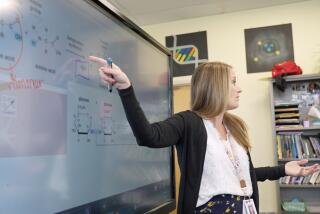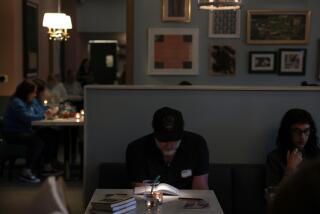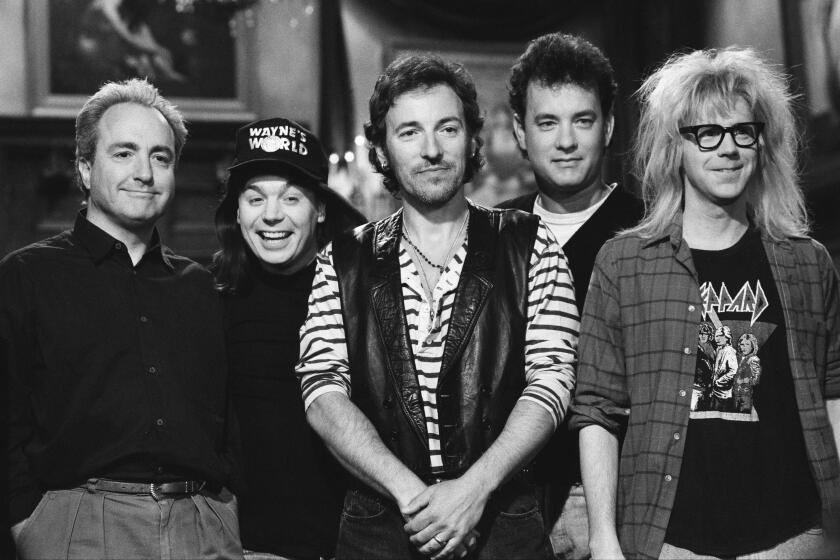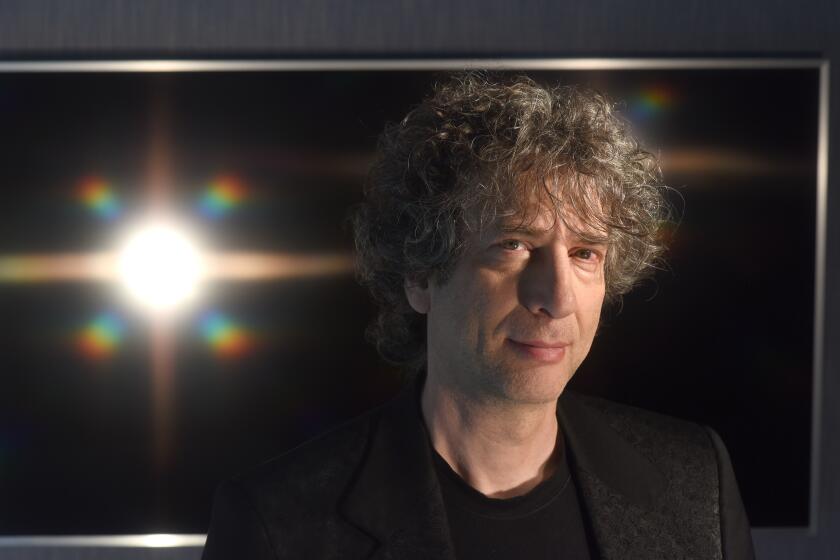Trouble in the Mecca of Reading
- Share via
AUCKLAND, New Zealand — Given that reading instruction has become one of the major exports of this emerald green spine of islands, right up there with kiwi and lamb, the critics here seem almost unpatriotic when they spout off like naysayers everywhere:
What’s wrong with our schools?
Reading has been a source of national pride in this tiny nation since 1970, when its students finished first in the world on an international test.
Within two years, Marie M. Clay, an Auckland child psychologist, was touring the United States, touting her views on how kids “emerge” as readers, based on years of watching them, one on one.
Then came Wendy Pye, a shoot-from-the-lip publisher who in the 1980s helped market this nation’s distinctive “little books” for beginners, some just eight pages long, in which colorful cartoons tell a story so simple that the children almost do not need the words below. As in “Huggles Goes Away,” in which a purple creature takes “Some clothes” “Some toys” . . .
On her way to distributing 85 million books around the world, Pye soon was rich enough to breed thoroughbred horses and boast, “I’m the lady that took it to America and made it happen. I’ve transformed barren classrooms into magic places of learning.”
By the 1990s, teachers in all 50 states, especially California, were filling hotel ballrooms to learn how they could abandon traditional phonics lessons and create “child-centered” classrooms. Their gurus were former New Zealand principals and teachers, anointed as $3,000-a-day consultants.
So why, then, does New Zealand have its knickers in a knot over reading? Why are the practices that for decades received gospel-like respect now denounced by some prominent academics as “snake oil” or “nonsense”? Why do business leaders complain, just as in the United States, about workers who can neither read nor spell?
Last summer, the New Zealand government’s Educational Review Office warned that eight of 10 high school students in one part of Auckland were illiterate. University of Auckland researchers reported that nine of 10 working-class children in other areas were up to three grade levels behind. And 60% of indigenous Maori students come out of high school needing tutoring.
Then this: New Zealand’s 10-year-olds tumbled from first to sixth in the most recent international ranking of reading skills. Educators now have to explain why this nation is four spots back of its most avid pupil, the place that spends tens of millions of dollars importing its books and ideas--the United States.
Tension Between Two Approaches
Heading north from downtown Auckland to Onepoto Primary School on a weekday morning is reminiscent of crossing the Golden Gate Bridge from San Francisco to Marin County. Traffic is light even as, in the other direction, the bridge is jammed with business executives and professionals on their way from hillside homes to offices in the city.
But Onepoto’s students do not come from such families. Rather, the modest but well-kept school serves a pocket of deprivation amid plenty. The community’s white, or pakeha, families send their children to private schools or take advantage of a nationwide open enrollment policy to send them to public schools farther away--but with almost all-white student bodies.
That leaves Onepoto to serve Maori, Tongan and Samoan children, most of whose parents are unemployed and lack cars or even telephones--a testament to the economic hardship that has spread in the past decade as government social programs have shrunk.
“A lot of kids used to come to school already able to read, but the kids here come not being able to hold a crayon or even knowing their letters,” said Principal Alan Kick. “You have to go right back to the very basic stuff like writing your name.”
That doesn’t mean drilling in letters and their sounds. Instead, though some of the kids have never owned a book, they plunge into one the day they start school--on their fifth birthday--then spend 80% of their time writing, conversing and reading.
Well, perhaps “reading” is an exaggeration.
Seated cross-legged on the floor, teacher Faye Norman’s seven pupils chant along as she points to the words in an oversize volume called “Houses.” In only four days they have memorized--through daily repetition--the book’s simple phrases: “There is a green house.” “There is a red house.”
“How do you know this word is ‘green’?” Norman asks. The response, “We look at the pictures!” earns a hearty: “Good!”
Norman’s lesson, and the “Big Book” she is using, are New Zealand trademarks.
The large book enables her to call attention to words or letters she wants the students to notice. The theory is that children should be given a chance to extract “meaning” from a book even before they can “decode” the words using letters and sounds. They are expected to be creative in figuring out words they don’t know--if not by using the pictures, then with “cues” from the shape of the word, its first letter or from surrounding words.
“Sounding out” the letters of a word--the method used with past generations of American children--is discouraged.
The tension between the two approaches is fundamental, reflecting debates over educational philosophy, social mores and even the role of government. Does proficiency in math, for example, result from puzzling through a few engaging problems or from drills? Is self-esteem a product of praise or accomplishment? Should political power be dispersed or centralized?
Critics of New Zealand’s reading methods “assume learning is official, conscious and hard work,” wrote Warwick Elley, a professor emeritus at Canterbury University in Christchurch. “New Zealand teachers assume that learning to read is best when it is informal, natural, spontaneous, continuous and enjoyable.”
That was why New Zealand more than 30 years ago developed the series of “little books” filled with storytelling pictures.
By reading such books often enough--with their teacher or on their own--students “build up their knowledge of the patterns of language,” said Helen Depree, an Auckland consultant who works with school districts throughout California. “It’s a powerful way of getting kids underway and interested and enjoying it.”
In theory, students then will begin to notice that “green” begins with the “grrr” sound and “red” with the “rrrr” sound . . . and eventually use that knowledge to figure out other words.
Thus no need for lessons in phonics.
“There’s no point in deliberately teaching or testing those skills,” said professor Elley. “They learn them quite naturally.”
That is the philosophy known today as “whole language.”
Linguists and educators in the United States began promoting it about the same time it was becoming policy in New Zealand. But American texts and work sheets were developed to teach phonics. So American educators tried to substitute classics of children’s literature, only to find that the likes of “The Little Engine That Could” were too hard for beginners.
In 1982, Wendy Pye teamed up with an American publishing executive and his wife, Tom and Aileen Wright, to distribute New Zealand-style books in the United States.
“The one thing no one could deny was that the reading materials had become very bland, uninteresting and boring,” Wright said. “At the time there was still skill and drill and phonics. . . . The kids were getting turned off.”
Wright believed that Pye’s “interesting, colorful, fun” books might bring a “breath of fresh air” to American schools while adding structure to “whole language” teaching.
By last year, the Wright Group’s annual sales had grown to more than $50 million. Two million American children learn to read each year with Wright books and tens of thousands of teachers have attended their training sessions.
Meanwhile, the Rigby Education Co., started by New Zealand colleagues of Pye, began selling similar materials. So did other companies and, as the demand grew, major U.S. textbook publishers woke up. Now virtually all their programs include New Zealand-style big books, little books and lesson plans.
But even as interest in the methods was increasing in the United States, a sense of unease was building back home.
Changing Nation, Sliding Test Scores
Just as in the United States, social forces were at work. The middle class was shrinking. More mothers were working. For schools, that meant fewer children were getting time on their parents’ laps reading Mother Goose, playing rhyming games and singing the alphabet.
Demographic changes were sweeping the schools as well. Maori children, most of whom spoke nonstandard English, grew to 20% of the enrollment nationwide.
Then there were test scores--the measure that had once given New Zealand international cache.
The 1991 survey by the International Assn. for the Evaluation of Educational Achievement found that many children--especially Maoris and other minorities--did poorly. New Zealand had the largest gap between majority and minority children of any participating country.
The education establishment attributed the decline to the changes in the society. But newly emboldened critics, who had kept their doubts private, blamed the revered methods.
University of Auckland professor Tom Nicholsen, whose doctoral thesis at the University of Minnesota questioned the assumptions of “whole language,” theorized that many New Zealand children were not becoming fluent and fast readers because they struggled to figure out unfamiliar words.
“I would do it exactly the opposite way and that’s the difference of opinion we’ve got,” he said. “They see sounding out as one of the strategies, but the least important strategy. And I see it as one of the most important.”
It’s not enough, he said, to expect children to “discover” letter sounds. They need lessons and practice--as little as 15 minutes a day--in word families such as “at, sat, rat” or “hot, lot, cot.”
One ally is William Tunmer, an American expatriate and dean at Massey University who calls New Zealand’s philosophy of reading “whole nonsense.”
Tunmer is completing the most comprehensive reading study ever in New Zealand. The message, he said, is clear: “Word-level skills”--the ability to use letters and sounds to identify words, rather than context--”makes all the difference, in New Zealand, the U.S. or anywhere else.”
But the critics feel like religious heretics challenging Genesis.
Doris Ferry, for example, has been branded a “nutter.” She is an 81-year-old tutor who claims to have helped more than 1,500 students to read--using old-fashioned phonics drills.
She lives in Kapiti, an affluent suburb up the coast from Wellington, seeing students in an aluminum shed stocked with phonics books, magnetic letters and flash cards, all imported from the United States or improvised.
Some of her students slip in through a hidden rear door. Others slump in the back seat of the car when their parents drop them off. When a national television program filmed a story on Ferry, parents of her students appeared in disguises, fearing retribution at school. Her students have been banned from one school’s “whole language” tutoring program on grounds that her methods would confuse them.
Ferry remains undaunted. She said: “I’m out to change the system. My job is to bring back accountability. They’re definitely putting an image across that things are just wonderful here and they’re not.”
Still, few expect any overhaul of the nation’s approach to reading.
“While it’s not working for some kids, it’s working for large numbers,” said Hans Wagemaker, director of research for the ministry of education. “I don’t for a moment see them abandoning ‘whole language’ instruction.”
What’s more, “whole language” has bred a whole industry--and even some legends.
“Things only will change,” said Nicholsen, “if Marie Clay had a change of heart overnight and recanted.”
Proponents Stand Firm
At age 71, she is a dame of the British Empire. Also New Zealand’s Woman of the Year. So steely-but-elegant Marie Clay is not likely to renounce the life’s work that won her those honors.
As a school psychologist in the 1960s, she was struck that most children referred to her had problems reading. So she decided to watch and record the behavior of 5-year-olds to see how strong readers differed from weak ones.
They did use letters and sounds to identify words, she acknowledged--but drew more from the meaning of the other words and structure of sentences. So teachers should observe their students closely as they read, making sure they are progressing on all fronts, she said. “You can’t just let it drift.”
It sounded like a balanced approach, except that there was no place for explicit phonics training.
By 1972, Clay was discussing her findings at Harvard University. In the late 1970s, she developed an intense tutoring program for slow readers called Reading Recovery. It is now used at more than 2,500 sites in 49 states, 400 in California alone. The Los Angeles Unified School District has six Reading Recovery centers where teachers are trained to help struggling first-graders catch up to their peers.
Last month, Florida Gov. Lawton Chiles announced a plan to invest $14 million in the program. At his side was First Lady Hillary Rodham Clinton, lauding its record.
Independent evaluations of the program are mixed, though. True, most poor readers make progress. But some of that may result simply from maturing. And many children drop behind again after a few years. Moreover, the program can cost more than $7,500 per student--raising concerns that it is too expensive to reach large numbers.
That questioning is part of a broader reconsideration of the New Zealand methods. At a time when many educational critics are pushing for a back-to-basics approach, most notably in math instruction, there has been a backlash against “whole language” and the de-emphasis on phonics.
Leading the way is California. In December, the State Board of Education removed the books of the two main companies embracing New Zealand methods--Wright and Rigby--from the state’s approved list. That could cost Wright between $10 million and $20 million in sales.
Wendy Pye, the publishing magnate behind the books, said her program was misunderstood. But she’s a businesswoman--so she’s adding phonics work sheets.
She is also extending her reach. Pye now claims a “total global empire” that stretches to South Africa, Sri Lanka and Poland and includes TV shows, CD-ROMs and teacher training on the Internet. Books by New Zealander Joy Cowley, which Pye first published, can be found in virtually every school in America, with titles such as “Mrs. Wishy Washy,” “Hairy Bear, Hairy Bear” and “The Meanies.”
Meanwhile, school districts across California continue to pay consultants to train their teachers in New Zealand methods.
So whatever the doubts, the export of reading expertise remains a growth industry for New Zealand, where sheep outnumber people 14 to 1. The world thirsts for answers to “Why Johnny can’t read” and folks here still believe they have them.
They will point to a classroom of 7-year-olds at Baird’s Road Primary School in impoverished south Auckland. In the writing center, pupils compose essays about volleyball. In the corner, four boys hover around an overhead projector and read Mother Goose rhymes off the wall. Others listen to recordings of poems on headsets. In the middle of it all, others practice printing the letter “N” perfectly.
Books are everywhere--but no TV or computers. “They’re saturated really in books,” said assistant principal Aileen Hanley. “Wading in them. Heaps of them. Sharing books after lunch. Just reading . . . “
So it’s hard to argue with her or Pye, the great exporter.
“I’ll take on anybody,” Pye said. “Let’s set up some trials. I’ll give them a run for their money. Let me be accountable along with everyone else.”
On a recent trip to the United States, she found reason for optimism. She saw a picture in a San Bernardino County newspaper of Vice President Al Gore reading to a group of rapt children--from one of her books.
“That gives me heart,” she said. “You know what I mean?”
(BEGIN TEXT OF INFOBOX / INFOGRAPHIC)
New Zealand at a Glance
Geography: New Zealand’s North and South islands arc for 1,000 miles through the South Pacific, encompassing glaciers, sunny California-like beaches and, at the southern end, fiords.
Population: 3.6 million
Ethnicity: 10% Maori, 85% white
Official language: English
Government: Parliamentary A former British colony, it is still a constitutional monarchy and part of the British Commonwealth. First nation in the world to grant women the right to vote, in 1893.
History: Maori people were the only residents until the late 1700s, when Europeans began settling the islands. In 1840, the Treaty of Waitangi guaranteed the Maoris rights to land and natural resources in return for British sovereignty. In 1995, Maori protesters disrupted Waitangi Day celebrations, saying the treaty had been violated. Later that year, the government agreed to pay remunerations. Principal exports: Lamb, wool, paper, fish, fruits and vegetables.
Gross national product: $48 billion (1994).
Educational system: 692,000 students, 20% Maori. Spending per pupil between $2,100 and $3,600, depending on grade. (California spends $4,200 per pupil.)
More to Read
Sign up for our Book Club newsletter
Get the latest news, events and more from the Los Angeles Times Book Club, and help us get L.A. reading and talking.
You may occasionally receive promotional content from the Los Angeles Times.










